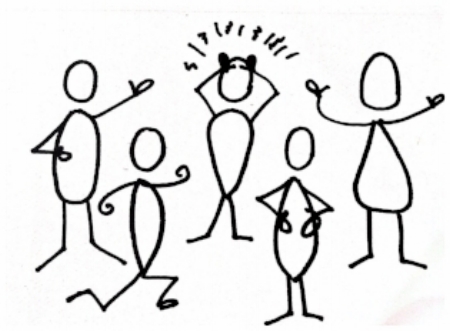Just for fun: how I learned to draw a gender inclusive stick figure
If you’ve ever seen me facilitate a workshop, you know that I like to incorporate drawings, doodles, and color wherever possible.
I am a visual processor. Images and diagrams help me understand things better.
I’m not alone. Many studies have shown that people retain, process, and comprehend information better if it is communicated with a visual.
So, years ago, when I went to my first graphic facilitation training, I was excited to build up these skills. Yet as I learned the different ways to draw figures of people, I began to wonder: why do they all kind of look like men?
My practice drawings at the visual facilitation training.
“Why are they all men?”
We were taught to draw people with broad shoulders and boxy figures, which are usually associated with maleness. Maleness is often the default for what is considered ‘gender neutral.’ Even the facilitator of this training was always referring to the figures as “guys.”
It was just another example of how gender influences everything, even our doodles.
Further, a nuanced understanding of gender calls for us to avoid simplistic drawings of male and female body types based on stereotypes that exclude diverse gender identities and expressions.
Design by Charrose King
I recently hired a friend to help me develop icons to use in graphics that would be inclusive of a range of body types and gender expressions. She came up with this basic design, on which we can layer different elements to indicate various gender identities and expressions.
And now I can apply this idea to my figures in visual facilitation.
My attempt to make more gender- (and body-type) inclusive figures.
We don’t know which figures are male, female, or non-binary; that’s not the purpose. Instead, we see diversity in body types that are more inclusive of multiple genders, and that’s a step in the right direction.
~ Lindsey
Here are some more tips for visual facilitation:
The key to drawing people is to keep the head separate from the body and draw the arms directly out of the neck.
Write and draw in black ink, then use color to fill in, shade, and add emphasis to words and images.
Bullet point markers are preferred over chisel point markers.
Avoid drawing fingers on your people figures. Instead, draw a circle hand or a mitten hand. Or, for a pointing hand, use a triangle.
When you are writing lists, stagger each point (the words) so that you leave enough space to add in visuals later.
Want to learn more? Check out these resources:



